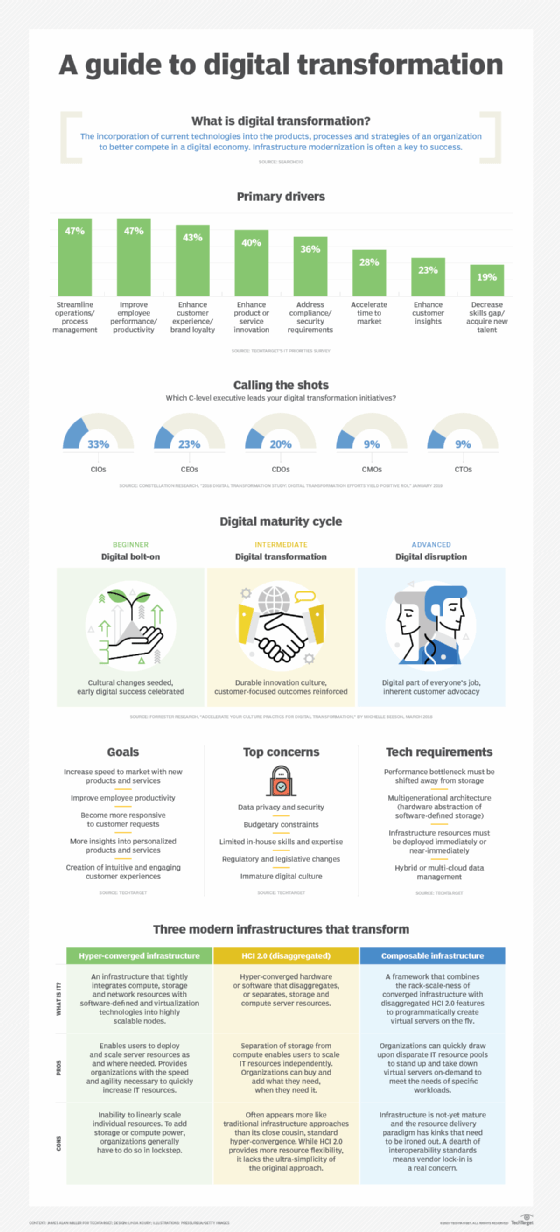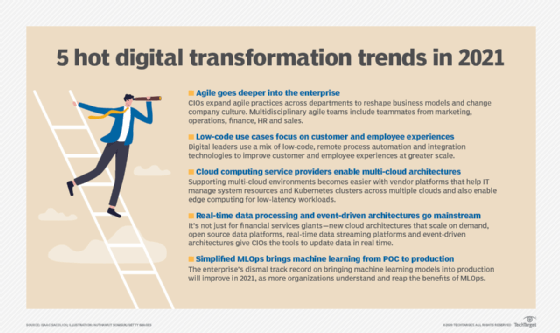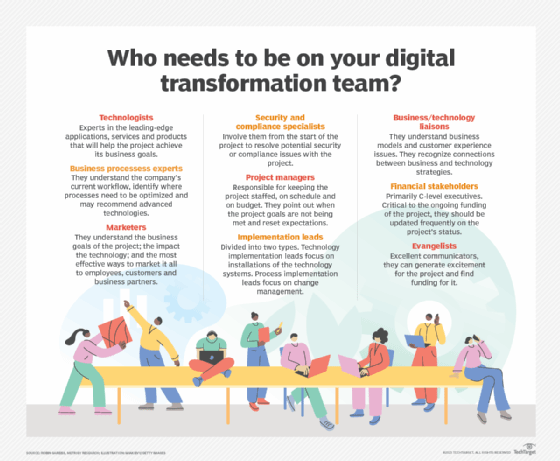
What is digital transformation?
Digital transformation is the incorporation of computer-based technologies into an organization’s products, processes and strategies. Organizations undertake digital transformation to better engage and serve their workforce and customers and thus improve their ability to compete.
Often large in scope, a digital transformation initiative can require an examination and reinvention of all facets of an organization, from supply chains and workflows, to employee skill sets and org charts, to customer interactions and value proposition to stakeholders.
Successful digital transformations yield ongoing business benefits: Digital technologies and processes enable organizations to adeptly respond to customer demands in the present and as demands evolve. Digital transformation also builds the infrastructure and skills required for taking advantage of fast-evolving technologies that could confer a competitive advantage.
A digital transformation strategy positions organizations to survive and thrive in a future where technology is the key economic driver.
Why is digital transformation important?
The digitization of society started in the late 20th century and underwent rapid acceleration in the first two decades of the 21st century, spurring a growing need for digital transformation across industries.
Indeed, many organizations believe they must either adapt to the changing market forces driven by digitization or face extinction. According to the Digital Transformation Index 2020 from Dell Technologies, a third of enterprise leaders are worried their organizations will not survive in the upcoming years, while 60% thought they’d survive but would shed many additional jobs and take years to return to profitability.
The need for transformation is exemplified in the often-cited case of Blockbuster LLC, which, in the early 2000s, was a global entity with video rental stores throughout the United States and around the world. But its presence and relevance precipitously declined from about 2005 onward, as Netflix and others harnessed emerging technologies and capitalized on the consumer appetite for on-demand entertainment delivered via highly profitable streaming video services. The power of digital technologies to disrupt is also evident in the rise of Amazon from online bookseller to an electronic commerce (e-commerce) juggernaut that redefined the retail industry.
The danger of market leaders being displaced and disrupted is expected to continue, as emerging technologies enable new business models, more engaging customer experiences, novel products and services, and other innovations.

What are digital transformation drivers?
Technology’s ability to rapidly collect, generate, analyze and transmit data is the principal driver of digital transformation. Artificial intelligence (AI), cloud computing, mobile technologies, social media platforms and next-generation technologies, such as the internet of things (IoT), edge computing and robotic process automation (RPA), have dramatically changed how quickly we get information.
The application of these technologies in the marketplace by digital leaders like Amazon, Airbnb, Uber and others has changed the kinds of products and services people expect. For example, consumers expect companies to respond quickly, as well as to provide products and services tailored to their needs. They have also have come to expect intuitive, easy-to-use interfaces, and they generally prefer digital interactions that can happen anytime from any device.
The same technologies affecting the consumer market are also are transforming workplaces by, for example, automating business processes that, until recently, were done manually; enabling work-from-anywhere environments; providing insights into ever-growing stores of customer data; and providing tools that facilitate collaboration among local and far-flung workforces.
What are the goals of digital transformation?
Digital transformation enables an organization to better serve its principal stakeholders: customers, employees, partners and shareholders.
The integration of computer-based digital technologies in business operations helps organizations do the following:
- increase speed to market with new products and services;
- increase employee productivity;
- increase responsiveness to customer requests;
- gain more insight into individual customers to better anticipate and personalize products and services; and
- improve customer service, especially in providing more intuitive and more engaging customer experiences.
What are digital transformation technologies?
Technology drives both the need for digital transformation and supports the digitization of an organization. Although no single application or technology enables transformation, several digital transformation technologies are critical to digitalization:
- cloud computing, which gives an organization quicker access to its software, new functionalities and updates, along with data storage, from anywhere at all times;
- commoditized information technology, which gives an organization the ability to focus investment dollars and people resources on the IT customizations that differentiate it in the marketplace;
- mobile platforms, which enable work to happen wherever and whenever;
- machine learning and AI, which, when fueled by comprehensive data programs, provide organizations with insights for faster, more accurate decisions around sales, marketing, product development and other strategic areas;
- automation, such as RPA, which deploys bots that can handle mundane, repetitive tasks faster and more accurately than humans who are then freed from such tasks to pursue higher-value work; and
- additional emerging transformational technologies that help organizations to move faster, work more efficiently, and create new products and services, including the following:
- blockchain
- augmented reality (AR) and virtual reality (VR)
- social media
- IoT
- edge computing

Digital transformation examples
Digital transformation can take different forms, but it generally falls into one or more of several categories: digitizing the customer experience, opening up new market opportunities, enabling innovation and increasing operational efficiency.
Examples of digital transformation success in business are plentiful. Here are four high-profile examples.
Nespresso. The maker of specialty coffee machines and operating unit of Switzerland-based Nestlé Group, Nespresso deployed a cloud-based customer relationship management (CRM) system that offered customers omnichannel access to shopping and customer service. Customers can reach the company whether they use the website, use a mobile device or visit a store. Having a single view of each of its customers — 360-degree view — has enabled Nespresso to move into more markets and improve sales.
Netflix. Founded as a mail-based digital video disk (DVD) rental company in 1997, Netflix reinvented itself as an online video streaming service that delivers customized offerings based on each customer’s preferences.
Capital One Financial Corp. Fueled by its digital innovations, Capital One became one of the top financial institutions in the United States as ranked by assets. CTO George Brady, in a November 2018 article on the company’s website, offered his insights into the company’s “four-year journey of disruptive change,” saying: “We don’t just use the latest technologies, we create them and infuse them into everything we do. We think of ourselves as a customer-centric tech company that provides innovative financial services, not the other way around.”
Domino’s Pizza. The 60-year-old pizza company successfully transformed itself for the digital age, launching innovative tech-driven services, such as its Pizza Tracker and mobile technologies that helped fuel significant growth in the past decade.
How to develop a digital transformation strategy
Successful transformation starts with a vision that articulates how to harness computer-based digital technologies to achieve strategic objectives based on the organization’s own digital business model.
Implementing cutting-edge technologies, no matter how promising they are, without understanding how they’ll deliver a return on investment (ROI) to the organization and its customers will not lead to transformation.
“What every company needs is a solid business strategy built around tomorrow’s digital capabilities,” Forrester Research analyst Nigel Fenwick said.
Each organization must have its own vision of success, but the following are steps that every organization should be prepared to take when developing a digital transformation strategic plan:
- Understand the market and the organization’s place in it, as well as its existing and potential customers.
- Analyze where the market is heading so the organization can anticipate the potential for digital disruption and how it can be the disruptor instead of being disrupted by others.
- Identify the existing and potential value proposition through internal evaluation and external research.
- Develop a vision for what the organization should be in the future, including how its products and services should evolve to meet customer needs and expectations.
- Create a digital transformation roadmap that offers a way to move from current to future state.
As part of this strategic planning, executives should assess the organization’s existing capabilities — from employee skills to its existing IT stack, articulating what additional capabilities will be needed and devising a plan to obtain those capabilities. Organizational leaders will need to draw on a number of traditional disciplines, such as project management, as well as new techniques, such as Agile methodologies, in order to successfully bring their organization, its culture, its people and its technologies into the future.
Digital transformation is not a one-time exercise. Experts agree that organizations must evaluate their digital transformation process and strategy on an ongoing basis and adjust it to maximize business value.
What are the benefits of digital transformation?
Digital transformation enables organizations to succeed in this digital age: That is the single biggest benefit of digital transformation. For businesses, that success means higher revenue and bigger profits. For other types of organizations, such as nonprofit institutions, the digital metrics for success they’ve implemented enables them to better serve their stakeholders.
Although digital transformation’s ultimate benefit is survival and strength in the future, transformation initiatives deliver many other advantages to organizations. They include the following:
- increased efficiency and effectiveness, as the implementation of technologies such as AI and RPA boost worker productivity, reduce errors and speed time to market — meanwhile, revamped business processes enabled by digital technologies further increase productivity and the pace of business;
- improved engagement with customers, employees and business partners, as organizations are able to better process data to make smarter, more accurate decisions and anticipate the needs of their different stakeholders;
- more agility and responsiveness to changing markets, as an organization’s culture and capabilities shift to support ongoing change; and
- enhanced ability to innovate, as a nimbler workforce and updated technology capabilities support and encourage experimentation, while also limiting risk.
These benefits help fuel ongoing transformation, as automation enables employees to shift to more innovative and higher-value work and more agility enables the organization to better identify opportunities and pivot resources toward seizing upon them.
What are digital transformation challenges?
A 2020 Gartner report found that, while 91% of organizations are engaged in some form of digital transformation and 87% of senior business leaders say digitalization is a priority, “only 40% of organizations have brought digital initiatives to scale.”
Everest Group found that 78% of enterprises fail in their digital transformation initiatives; the research firm cited unsustainable returns, limited user adoption and abandoned projects among the top reasons for failure.
The following are the most common reasons experts cite for why digital transformation failures happen:
- lack of employee engagement
- inadequate management support
- poor or nonexistent cross-functional collaboration
- lack of accountability
- data privacy and security concerns
- budgetary constraints
- limited in-house skills and expertise
- regulatory and legislative changes
- immature digital culture
One of the biggest digital transformation challenges for companies that were not “born digital” is legacy systems and applications — older technologies that don’t support digital initiatives, but can’t easily be replaced. If the leadership group refuses to pay to replace old technologies or fails to garner the necessary executive- and board-level support for investing in a technology overhaul, digital transformation is unlikely to happen.
The importance of culture to DX
Building a digital transformation culture is frequently cited as the single most important task for organizations engaged in transformational change. Leaders need to create an organizational culture where continual improvements happen and where stakeholders are open to ongoing change. Everyone must be willing to identify and abandon dated and ineffective processes and replace them with something better.
Most organizations, however, struggle to build a corporate culture capable of supporting transformation. A recent Dell Technologies report found that, while digital transformation has become “an imperative for all organizations,” only 48% of enterprises were sharing knowledge across business functions, and only 49% were investing in digital skills and digital talent. It also found that few have adopted Agile practices, with a mere 17% hosting hackathons and just 29% encouraging a fail-fast-then-succeed mindset.
Without attention to such critical cultural requirements, an organization could end up with modern technologies that enable more efficient or effective processes — such as ordering raw materials, taking inventories or handling payments — without truly transforming how the organization operates, what it has to offer its stakeholders and what value it produces for all involved.
How has the COVID-19 pandemic impacted digital transformation?
The COVID-19 pandemic accelerated many aspects of digital transformation, as organizations across nearly all industries were forced to limit or even abandon in-person transactions with customers, employees, partners and suppliers and virtualize as many interactions as possible.
A survey released by management consulting firm McKinsey & Co. in October 2020 found an increased use of remote work and collaboration, advanced technologies in operations and cloud computing as a result of the pandemic.
Here are some of the other ways in which the pandemic has had an impact on digital transformation, according to technology expert Paul Kirvan:
- more use of customer-friendly apps in the wake of widespread lockdowns;
- more use of self-service apps to speed customer data collection;
- more use of advanced e-commerce platforms, enabling organizations to modify supply chains to accommodate shifts in demand;
- increased use of AI in data analysis to analyze data from advanced e-commerce systems; and
- evolution of chief information officer (CIO) role from enabler to a full-fledged partner in achieving business goals.
Digital transformation team roles
Building the right team for a transformation effort is the most important component of a successful digital transformation strategy, according to Metrigy CEO and principal analyst Robin Gareiss. The effort “starts with good leaders — typically C-level executives with budget, influence and respect,” she said. The chief executive officer (CEO) usually appoints the person in charge of the digital transformation initiative. At some companies, this might be the chief digital officer (CDO) or a person hired specifically to work on digital transformation, or the project might be the responsibility of the CIO, chief technology officer (CTO) or chief operations officer (COO), who spearheads the initiative in addition to their other duties. Other key roles described by Gareiss in her tip on how to build a digital transformation team include the following:
- Business-technology liaisons. They understand business models, customer experience issues, and technology strategy.
- Evangelists. Highly skilled communicators, they generate excitement and find funding.
- Financial stakeholders. These are typically C-level executives.
- Project managers. They develop detailed projects plans, keep the project running and raise red flags.
- Marketers. They advertise digital transformation benefits internally and externally to customers and shareholders.
- Implementation leads. IT leads focus on the technology installation, and the process leads focus on change management.

IT teams handle a significant amount of the work associated with the selection, implementation and management of the technologies that enable and drive the initiative. The IT team working on a digital transformation initiative must be able to innovate, test, deploy and scale projects quickly.
Critical IT roles for digital transformation include the following:
- cloud architects
- data architects
- digital product managers
- information security (infosec) leaders
- scrum masters
- systems integrators
- user experience (UX) engineers
How to measure digital transformation ROI
Digital transformation is a broad undertaking with no singular endpoint; it typically requires multiple ongoing initiatives that involve investments in new technologies, new skills, an updated workplace culture and even organizational restructuring.
Despite the overarching nature of digital transformation, organizations can indeed measure how well they’re doing on their digital transformation journey and whether their investments are delivering returns.
Executives can measure ROI delivered by digital transformation initiatives as they would quantify ROI on more conventional projects:
- Identify the objectives or goals of a particular initiative that supports the organization’s digital transformation strategy.
- Determine the components and associated costs to deliver on the initiative.
- Define the metrics that will determine whether, and how well, the identified objectives and goals were achieved, using those compared against costs to determine ROI at various points along the organization’s transformation journey.
